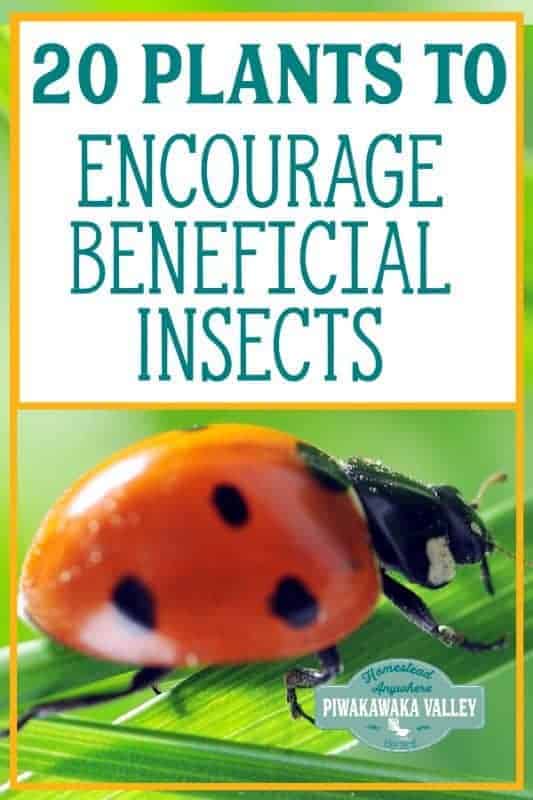This post was most recently updated on April 7th, 2020
Part of permaculture is the art of growing plants to benefit everyone, and to attract beneficial insects to help control pests and disease without sprays. There are some specific plants that encourage beneficial insects to move in to and stay in your garden.
Please read: This information is provided for educational purposes only and is not intended to treat, diagnose or prevent any disease. We encourage you to make your own health care decisions in partnership with a qualified health care professional.
This post contains affiliate links, this means at no extra cost to you, we make a commission from sales. Please read our Disclosure Statement
What are beneficial insects?
Beneficial insects sit into two main categories:
- Those that affect pollination where that is required in the fertilisation of flowers to produce seeds; this may be for food crops.
- Those that prey on other insects that can be pests to the gardener or grower. In other words they carry out natural pest control.
This last activity is what the whole principle of biological control is based upon.
The idea is that you introduce one bug which eats another bug. By encouraging beneficial insects in your garden you can achieve this naturally by encouraging a balanced environment where there are predators and prey for them to feed upon.
These beneficial or ‘good’ insects eat or otherwise prey on garden pests. Sweet alyssum attracts hoverflies, and their larvae eat aphids.
When you mix a bunch of these beneficial plants, your attract a range of beneficial insects.
RELATED: 40 plants to attract bees
How do you attract beneficial insects in to your garden?
Here are some simple steps the gardener can take to encourage beneficial bugs in to your garden:
1. Avoid chemical insecticides
This is especially those broad-spectrum pest killers that kill any insect. These will kill off beneficial insects as well as those they prey upon which are probably the pests you want to ill.
Also, if you keep using them eventually a bug may develop a resistance and re-establishes itself.
If you do need to use a pesticide at all, try and use a natural organic one that is non-residual in the environment. Use only in early morning or late evening. Be sure to use it selectively, as a contact pesticide sprayed directly on to the pest you are trying to kill.
2. Plant a wide variety of nectar and pollen plants in your garden.
These will provide food throughout the year for bees, pollinators and other beneficial insects.
See below for a selection of plants that work really well for this. Plant in larger groups as makes the flowers easier for the insects to find.
3. Use all the layers and space with your plantings
Include a variety of trees, shrubs and climbers in your garden. This is because, the more habitats you provide, the greater the variety of insects that are likely to move in.
RELATED: How to grow the BEST strawberries
4. Include native plants in your garden.
These are more likely to be the food plants and breeding ground for native beneficial insects.
Often native woody plants can be incorporated into hedgerows. Why not just let the clover and other small leaved flowering plants to invade your lawn.
5. Don’t be too tidy but avoid bare ground.
Nature hates bare ground. Bare soil leaves ground dwelling bugs exposed and they are less likely to move around looking for food. But in the same vein, keeping things too tidy removes the hiding places for beneficial insects.
6. Provide an insect house for beneficial insects
This is easily constructed from canes, twigs, cones, bricks and timber. Or you can get one like this:
If you want to make your own, old pallets make a great base and this can be an attractive feature.
7. Make sure there is a water supply
Insects, including bees, need water as much as they need food. They will drink from shallow puddles; you could provide saucers filled with stones and clean water.
What plants to sow to attract beneficial insects by season
The aim is to provide the food – nectar and pollen that the beneficial insects need right through the growing seasons. Try to choose plants that flower at different times to keep the food source up.
Spring
Coriander
Mustard
Mizuna
Radish
Rocket
Phacelia
Early Summer
Alyssum
Asian brassicas – pak choy and bok choy
Borage
Comfrey
Coriander
Dill
Fennel
Monarda
Phacelia
Mid Summer
Alyssum
Asian brassicas – pak choy and bok choy
Borage
Buckwheat
Catmint
Comfrey
Coriander
Dill
Fennel
Monarda
Phacelia
Late Summer / Early Fall
Alyssum
Borage
Buckwheat
Catmint
Goldenrod
Oregano
Phacelia
What plants to grow to attract different beneficial insects
Different species of beneficial insects prefer different types of plants.
Plants to attract Hoverflies
Achillea
Alyssum
Anthemis tinctoria
Buckwheat
Coriander
Dill
Feverfew
Golden rod
Mustard
Phacelia
Parsley
Plants to attract Lacewings
Achillea
Angelica
Anthemis tinctoria
Buckwheat
Canola
Caraway
Coreopsis
Coriander
Dill
Feverfew
Goldenrod
Mustard
Pak choi
Sunflower
Plants to attract Ladybirds
Achillea
Alyssum
Angelica
Buckwheat
Calendula
Caraway
Chives
Coreopsis
Coriander
Cosmos
Dill
Fennel
Feverfew
Goldenrod
Plants to attract parasitic wasps
Buckwheat
Canola
Coreopsis
Dill
Fennel
Queen Anne’s Lace
Mustard
Pak choi
Zinnia
If you would like help getting the most out of your garden, I would love to help you, find out more here
RELATED: Free Gardening Resources
If you like tips on frugal living, self sufficiency and consuming less, sign up to our newsletter below, I would LOVE to have you
For further reading, I also recommend all of these books. I own every one of them and they are amazing resources!































